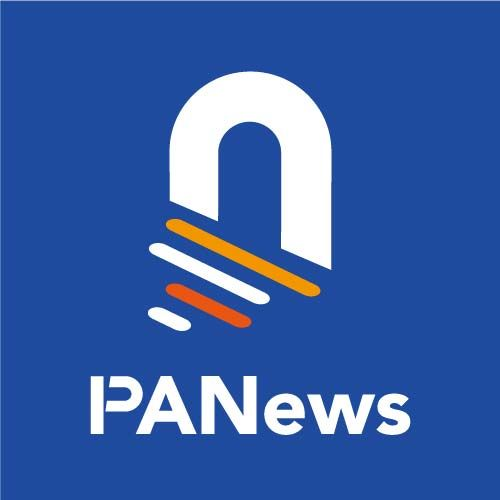Original author: Noam Segal , Crypto KOL
Original translation: Felix, PANews
Crypto KOL Noam Segal released a survey report on the use of technology tools (more than 6,500 participants participated in the survey). The survey covers 13 categories, from AI assistants to project management to CRM (customer relationship management). In addition to asking what tools are used, people were also asked what tools they like most, what tools disappoint them, and what they would use instead if they could.
Of the respondents, 50% work in product, 11% are engineers, 10% are founders, and the rest work in other cross-functional roles including marketing, design, and growth.
The breakdown of the respondents’ company sizes is as follows:
About 45% work in companies with 1 to 100 employees
About 25% work for companies with 101 to 1,000 employees
About 20% work for companies with 1,001 to 5,000 employees
If companies with fewer than 1,000 employees are defined as “non-large enterprises,” then approximately 70% of respondents work at startups or mid-sized companies, which can be described as an early adopter group.
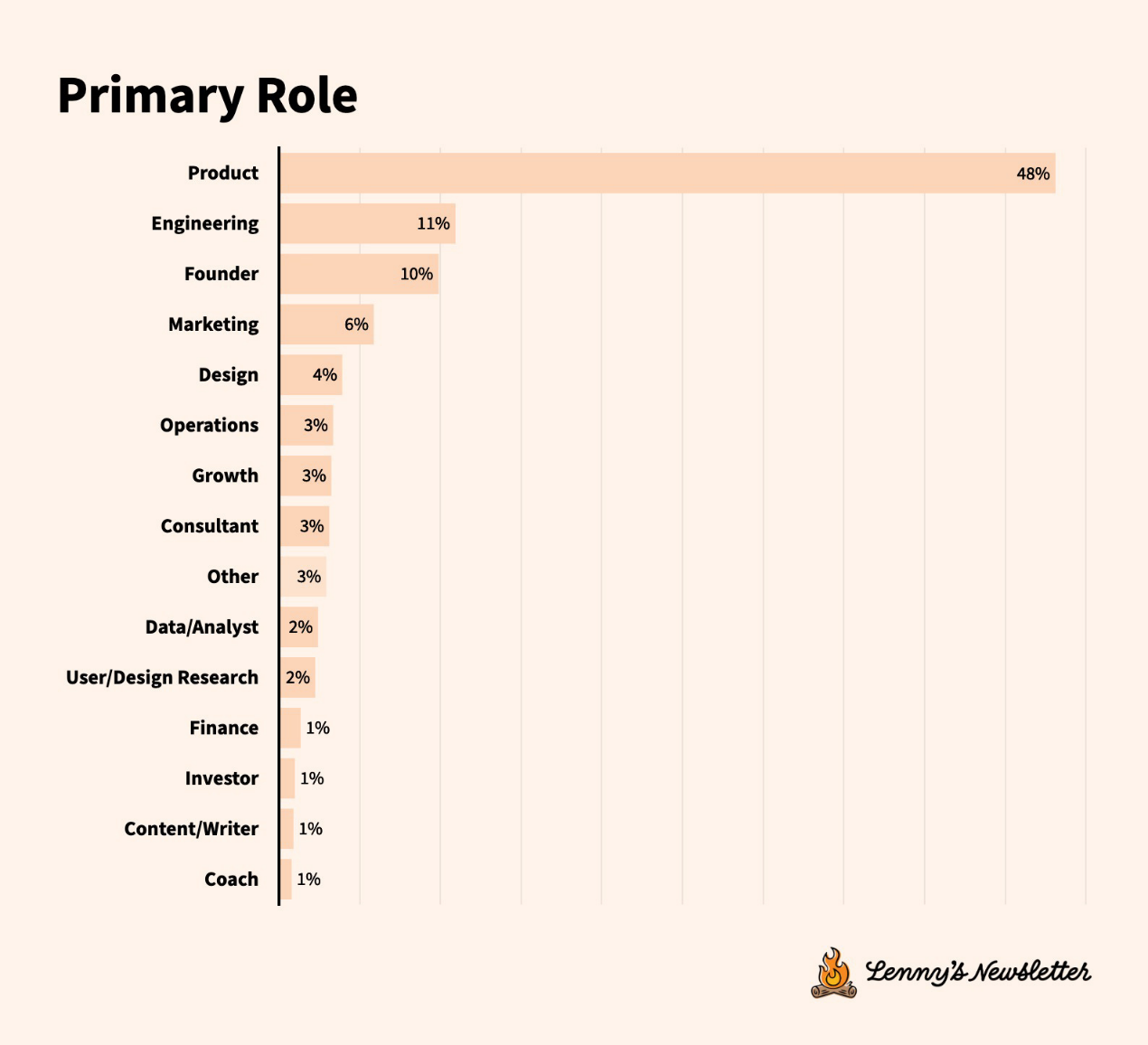
10 key takeaways:
ChatGPT is far ahead. 90% of respondents use ChatGPT regularly. Only 35% use Claude and 24% use Gemini.
Cursor and other AI-native integrated development environment (IDE) tools are emerging rapidly. 17% of respondents regularly use Cursor (launched two years ago). 10% of participants use v0 and Replit. 5% use Bolt.
Slack continues to lead overwhelmingly as the third most used tool overall. 72% of participants use Slack regularly, second only to ChatGTP and Gmail.
Jira is used by 68% of participants, but it also tops the list of tools they wish they could use. Linear is the fastest growing Jira alternative, used by more than 10% of respondents.
Figma Slides and Canva have become important tools in the presentation field, far ahead of Apple Keynote and approaching PowerPoint.
Google Docs remains the top choice for collaboration tools, but Notion is gaining momentum. Notion is seen as a “jack of all trades” and is catching up to other well-known tools, with 37% of respondents preferring Notion. Notion also ranks second in project management after Jira and fourth in CRM.
Figma remains the most ubiquitous design tool. 97% of designers report using it as their primary design tool. Canva is still far behind, but is catching up, thanks to its widespread popularity among marketers and founders for general design needs.
Miro continues to lead FigJam in virtual whiteboards, just by a hair. But FigJam is gaining ground.
Notion and Slack were pleasant surprises in CRM and customer support. It turns out that tool flexibility is important even when facing strong incumbents.
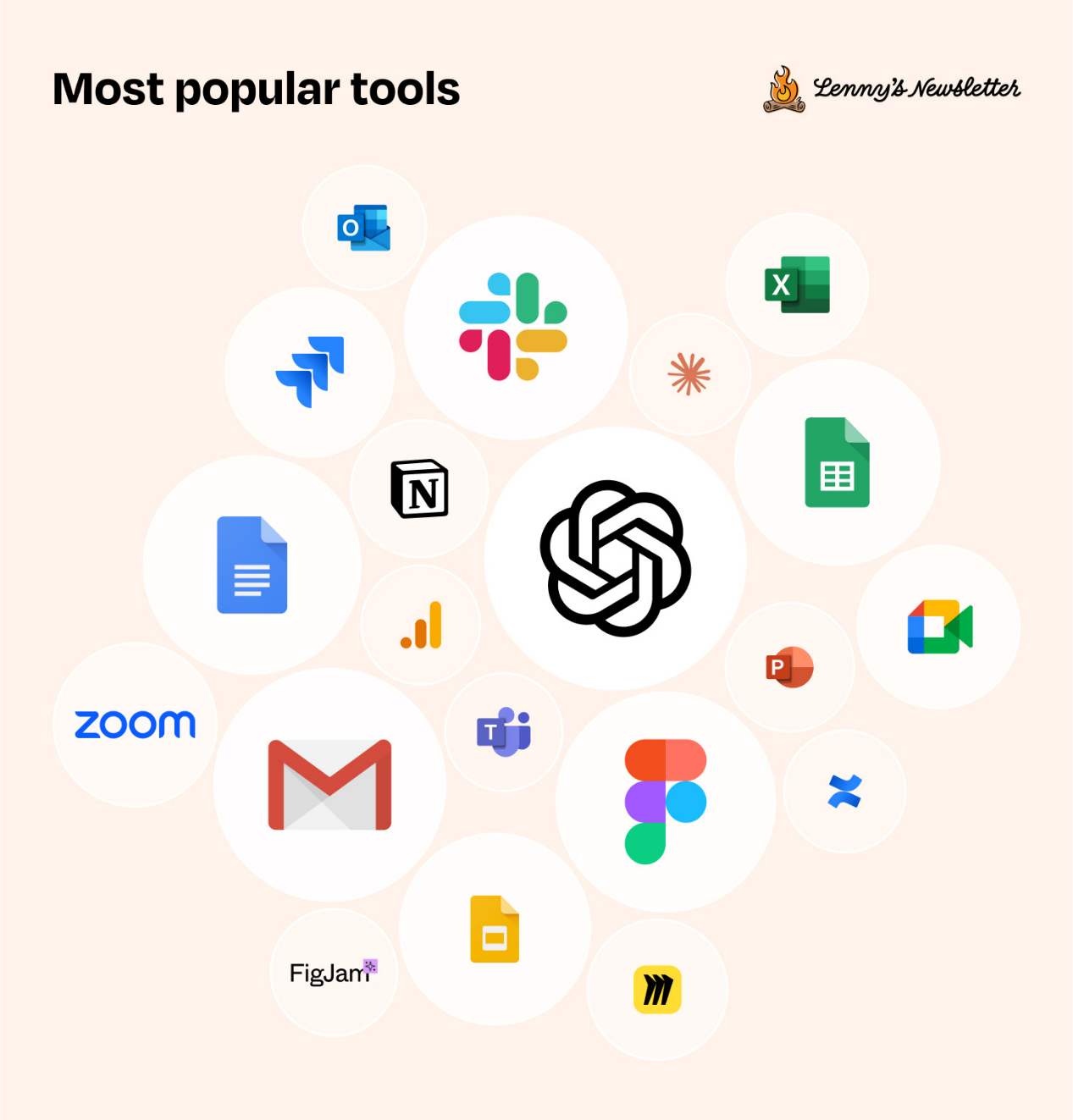
Three basic points: bundling, smart design, and mixing and matching. More on that below.
ChatGPT is far ahead
What’s the most notable shift from 2022? AI tools have become as important as laptops. A whopping 90% of respondents use ChatGPT regularly. This is the most significant shift in product teams’ tool stacks in recent times. More respondents use ChatGPT than Gmail (76%) or Slack (71%).
Interestingly, over 50% of respondents are combining AI assistants for specific use cases:
ChatGPT + Claude as Thought Partner
ChatGPT + Perplexity for in-depth research
ChatGPT + Gemini for Google Workspace integration
Role-specific AI tools are also growing in popularity:
40% of engineers regularly use GitHub Copilot
21% of engineers use Cursor
Although not mentioned, tools like ChatPRD and Grammarly are growing in popularity.
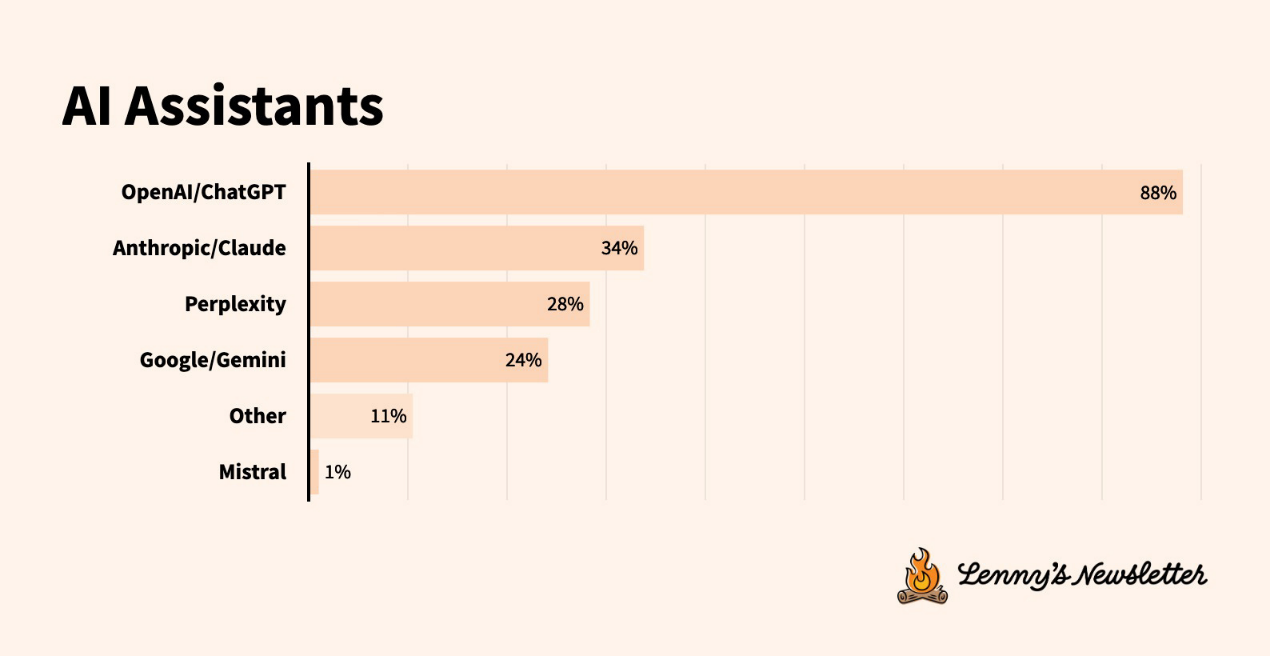
Cursor and other AI-native IDEs are rising rapidly
The second most important shift in the tool stack is the emergence of AI-native development environments, which are already used by 17% of overall respondents (and 21% of engineers in the sample), despite tools such as Cursor not being launched until 2023. Nearly 10% of respondents are already using tools such as v0 and Replit, and 5% are using Bolt. 60% of them are product people, and 40% are other roles, including engineers, founders, consultants, marketers, designers, and user experience researchers. Most of these tools were launched more than a year ago.
This rapid adoption shows that developers are hungry for tools that simplify coding and integrate into their coding workflows.
Nearly two-thirds of respondents use GitHub; however, the most popular “other” tool is GitHub’s main competitor, GitLab.
VS Code has a strong presence among engineers, with an adoption rate of 48%. VS Codes success reflects its technical capabilities and Microsofts success in evolving the platform into a highly extensible, community-driven tool.
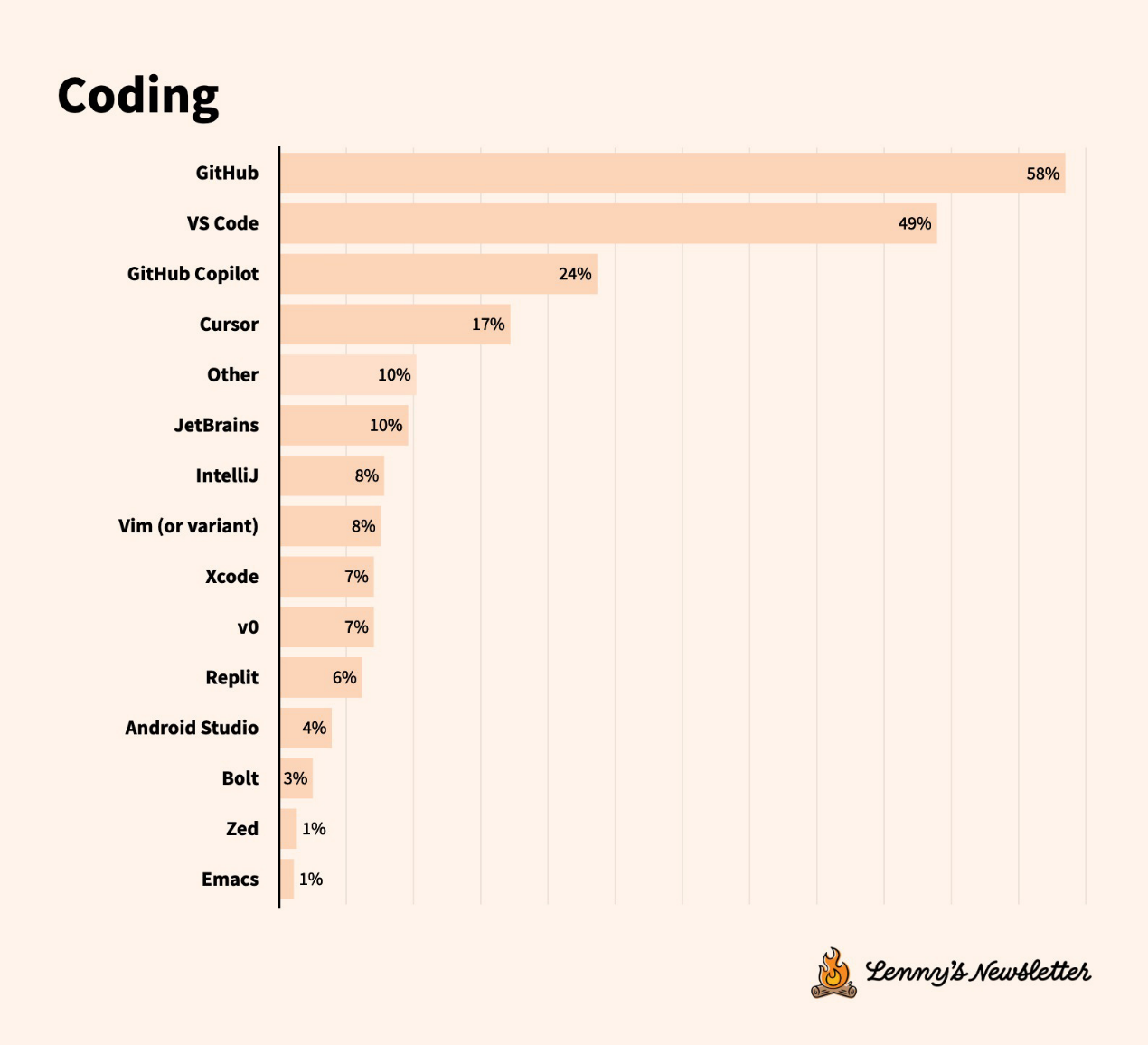
Slack continues to lead as the third most used tool
In previous surveys, Slack ranked first overall. That trend continues here, with 72% of respondents using Slack as their primary communication tool (second only to Gmail).
Technically, Microsoft Teams has about 33% of the market share, but this is due to their enterprise bundling strategy, and actual usage is not as good as people think. As mentioned in the section on switching tools below, users don’t like using Teams.

Why did Slack stand out? Two hypotheses:
Teams has a low user experience rating. It’s rumored to be cumbersome, slow, and even “unusable.” In terms of user experience, Slack wins.
According to public data, Microsoft Teams is mainly used by non-tech companies and has been adopted by most large U.S. companies. In contrast, Slack is mainly used by startups to mid-sized companies. Most of the respondents to this survey work at companies where Slack is dominant.
Another interesting finding: up to 20% of respondents use WhatsApp for work, while Telegram has also made inroads in work communication, with 15% of respondents who chose other tools using Telegram every day. WhatsApp and Telegram were never designed as work communication tools, but a significant number of people are using them as work communication tools.
The Jira Paradox and the Rise of Linear
It’s an interesting paradox: Jira dominates the project management market (used by 53% of technical teams, the largest share), yet it’s at the top of the “want to switch” list. Its deep integration with development workflows, bundling with other products, and enterprise-first feature set lock teams in.
Feedback from respondents indicated that Jira was too complex and difficult to learn and use. One respondent said, “Jira is a mess, performs poorly, and is difficult to maintain. It is complex, has a lot of features, and a poor user experience.” Another participant said, “Jira is too complex/bloated for our needs. I find it cumbersome and could use more simplicity to its functionality.”
Linear: The fastest-growing Jira alternative, founded in 2019, is already used by more than 10% of participants (up from just 10 mentions in the last survey). Respondents praised its modern, intuitive interface and simplified workflow management. One engineering manager said: Just switched to Linear from the Atlassian suite, much more useful in terms of milestones and flexibility. Easier to filter views and build a personal workspace setup. Linears popularity is comparable to Asana, which was founded in 2008.
Meanwhile, Notion has become the second most popular project management tool and the fourth most popular document, and it is gaining popularity as a CRM tool. Respondents unanimously praised its flexibility. 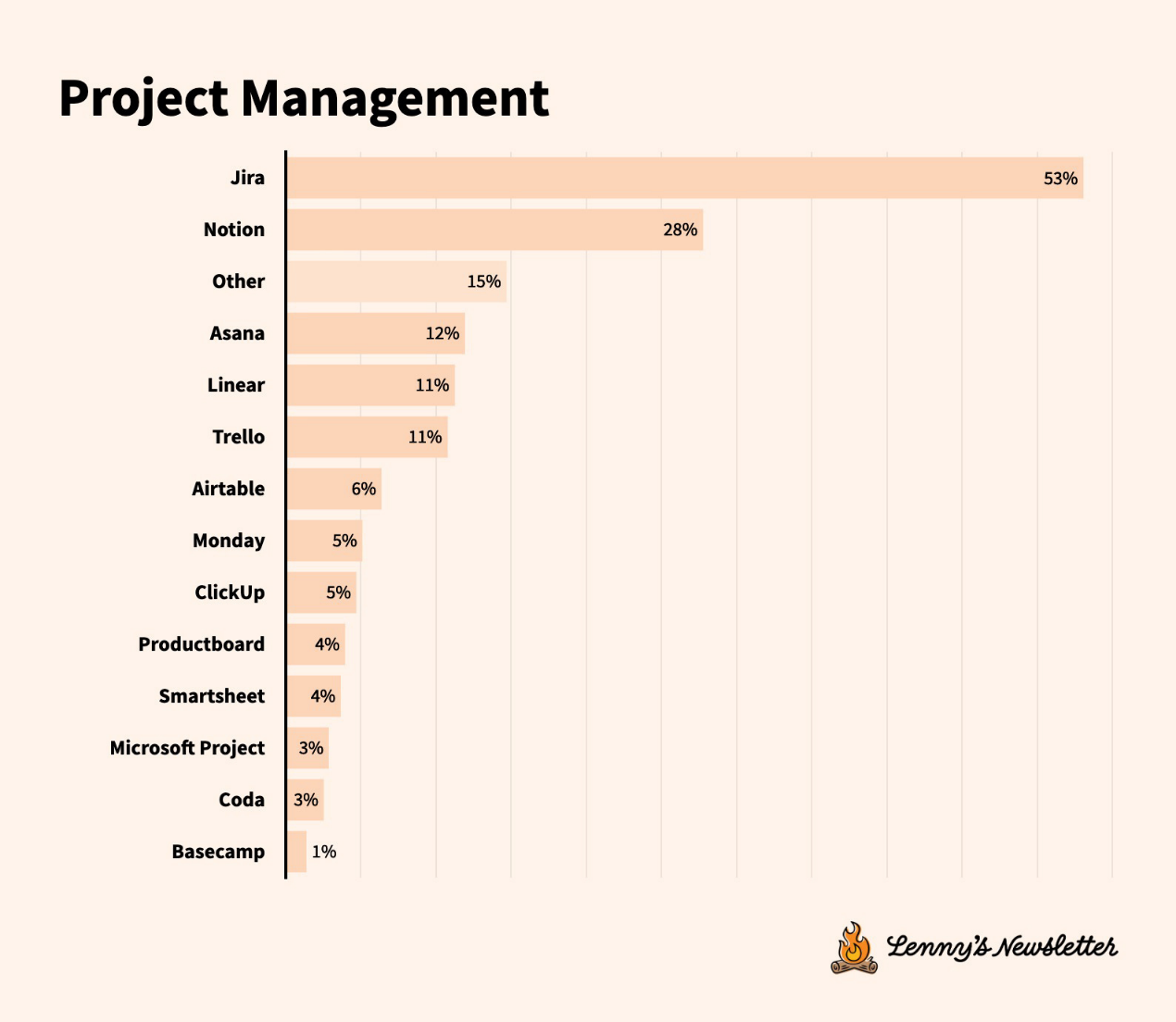
Figma Slides and Canva have become important tools in the presentation field
The way users create presentations is evolving in amazing ways. Three distinct approaches have emerged, each telling a different story about how visual communication will be done in 2025.
First up, the old guard. Google Slides and PowerPoint continue to dominate traditional presentation creation, doing what they’ve always done well.
Yet design tools are creating a quiet revolution in the presentation space. Figma and Canva have emerged as strong contenders, with similar adoption rates. This may come as a surprise to those who primarily use these platforms as design tools. What’s driving this shift? Respondents consistently report that these tools offer something that traditional presentation software can’t: creative freedom without the complexity.
AI is also making its way into presentations. New tools like Pitch, Gamma, and Beautiful.ai are fundamentally rethinking how presentations are made. Instead of starting with a blank slide, these tools use AI to shape your content into a polished presentation. While these tools are still finding their footing in the market, early adoption signals hint at a major shift in how slides will be made in the future.
Another trend emerged in the data: Miro consistently showed up in the “Other” category, suggesting that people aren’t just switching up presentation tools, they’re questioning whether they even need traditional slides. The lines between presentations, whiteboards, and collaboration spaces are blurring, and this may just be the beginning.
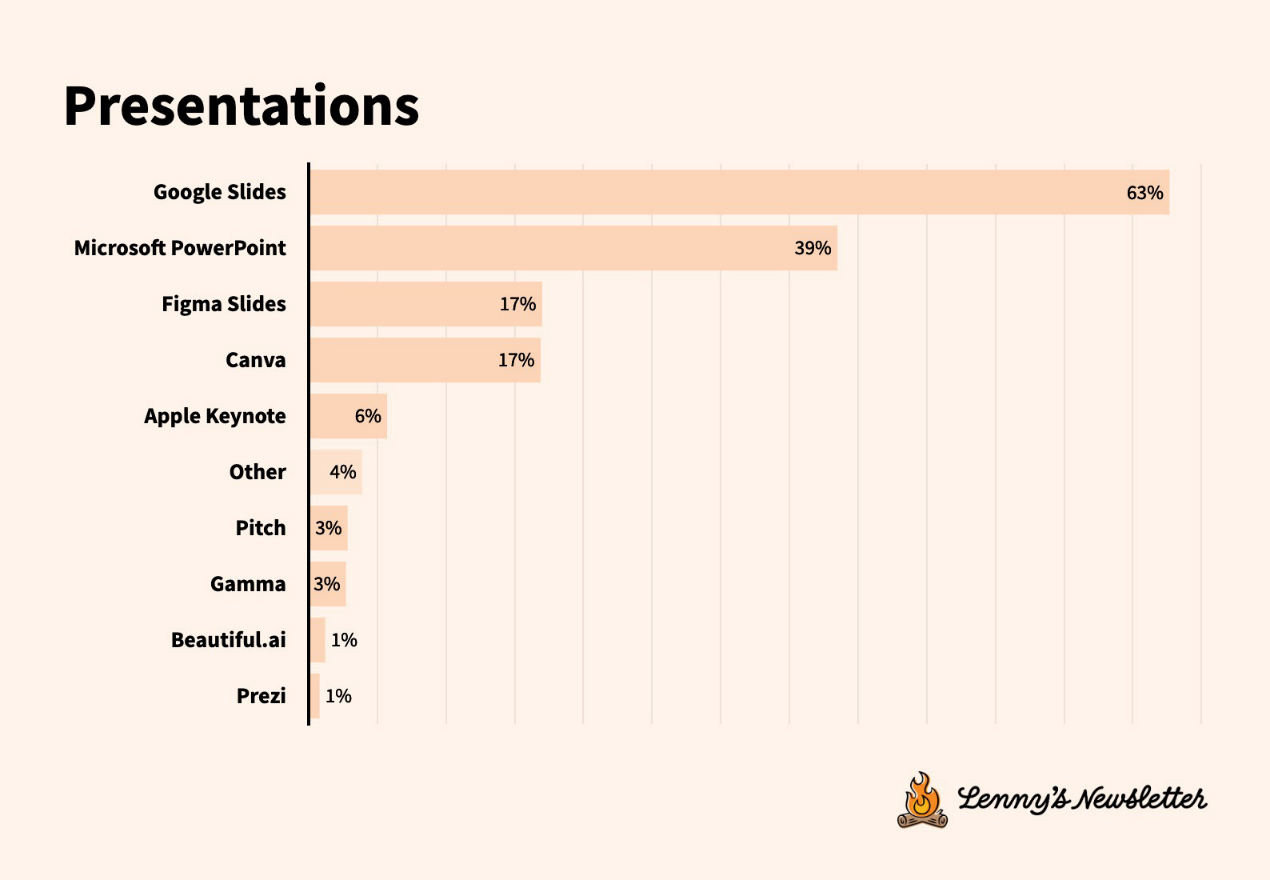
Google Docs is still the collaboration tool of choice, but Notion is gaining momentum
The documentation landscape is organized around three platforms, each serving different needs:
Google Docs remains the top choice for real-time collaboration.
But Notion, as a rising star, has an advantage in team wiki, project management and documentation.
Confluence remains popular among enterprise teams (despite complaints).
Google Sheets continues to gain ground in the spreadsheet world, but Excel has proven surprisingly resilient, while tools like Evernote, Quip, Coda, and Dropbox Paper are fading from the spotlight as companies look to consolidate their tool stacks.
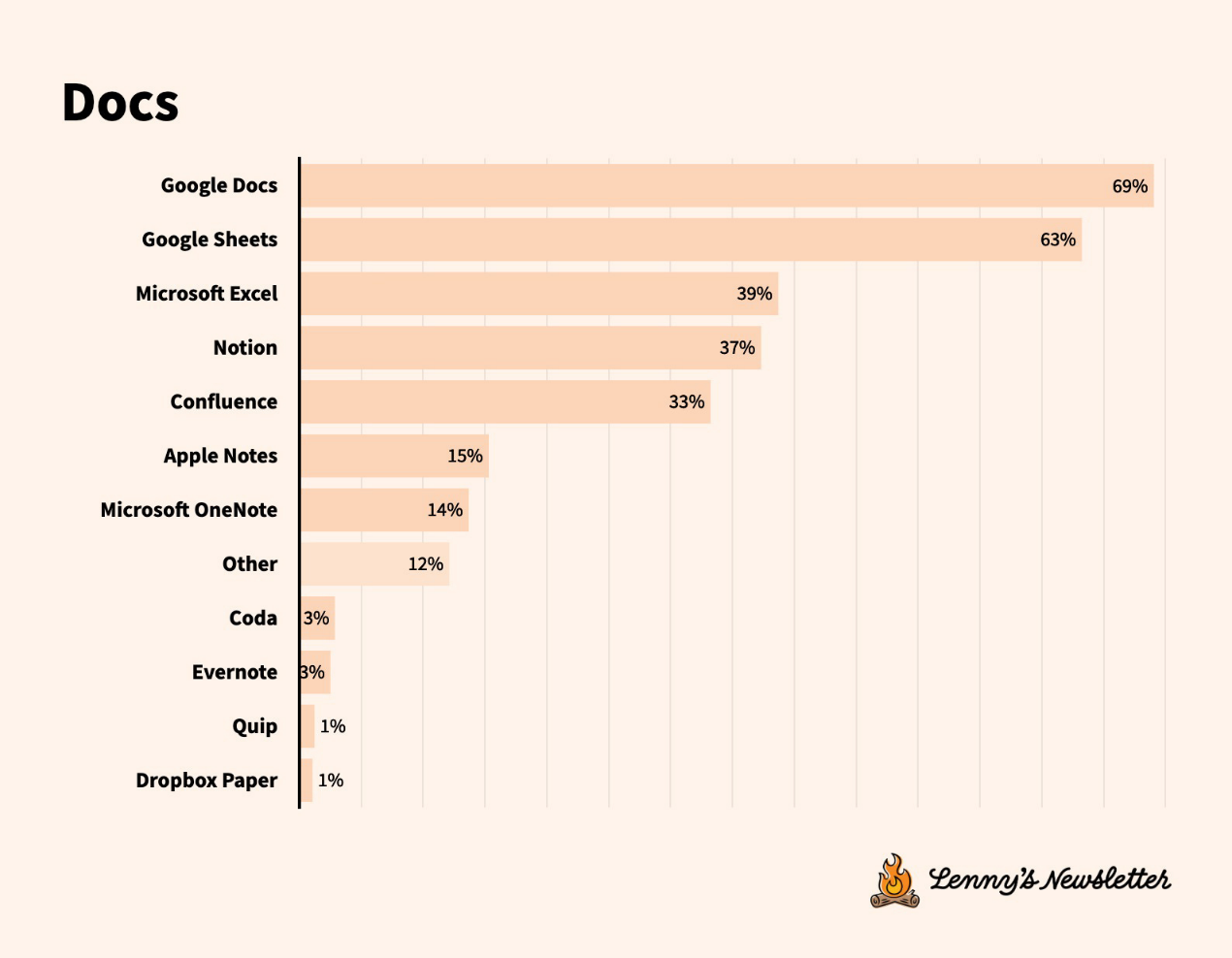
Figma continues to be a tool for design and UX
If you work in design, you almost certainly use Figma. 90% of participants and 97% of designers use it as their primary tool.
An unexpected tool is Canva. While it doesn’t directly compete with Figma for professional designers, it democratizes design for everyone else. Product managers, marketers, and engineers are using Canva to create quick visuals without disrupting their design teams.
Miro is slightly ahead of FigJam in the virtual whiteboard space
Miro is still the leader in the virtual whiteboard space, but only slightly. As you just read, Figma is a design tool, so FigJams dominance may force Miro to lose its leadership position in the next few years.
Perhaps observing Figma’s approach, Atlassian and Microsoft have developed virtual whiteboard products, which were mentioned in about 5% of responses. Mural and Whimsical did not seem to grow.
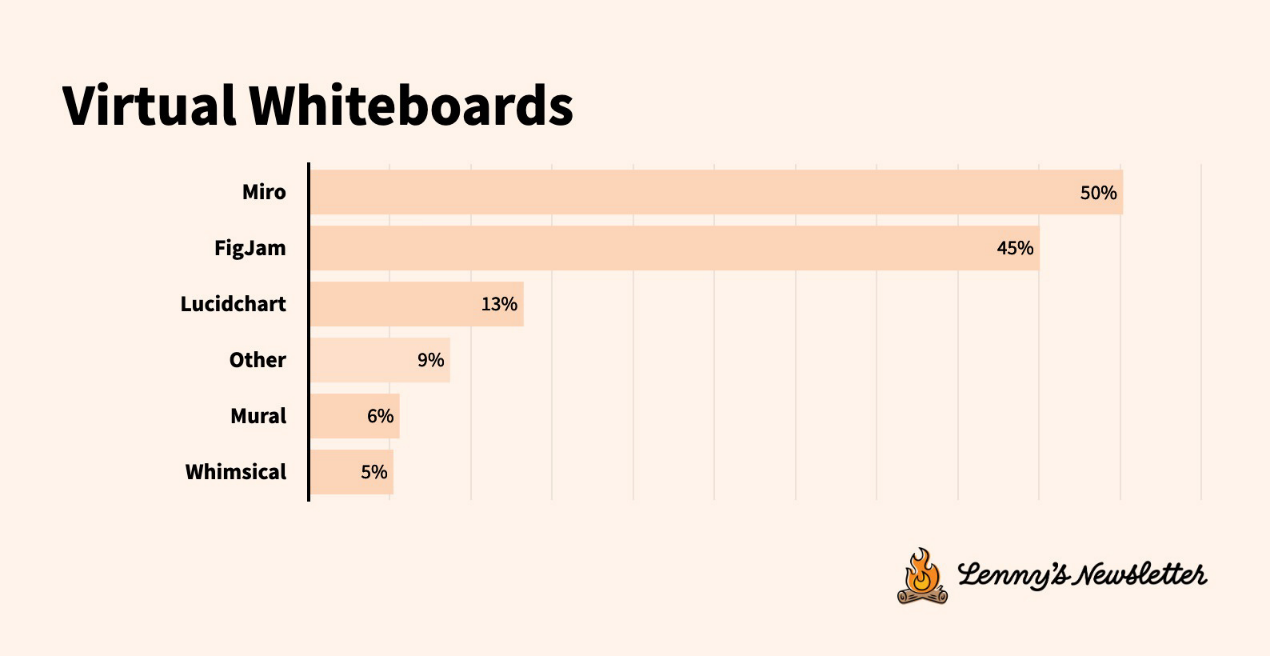
Notion and Slack are the surprise hits for CRM and customer support
Two companies dominate the CRM space, but there is an unexpected entrant into the market.
Salesforces comprehensive enterprise capabilities make it the default choice for large organizations, but a growing number of smaller companies are dissatisfied with its complexity and cost structure. This creates an opportunity for alternatives that emphasize simplicity and specific use cases.
HubSpot fills this gap in the market, especially among small and medium-sized businesses. Respondents said HubSpot is more intuitive and streamlined than Salesforce, and teams can use it even without a dedicated CRM expert.
But then there was a surprise. 11% of respondents chose Notion as their preferred CRM. According to the results, flexibility is key to its success: “Notion provides a ton of flexibility for our team, which is probably the hardest thing to replace.”
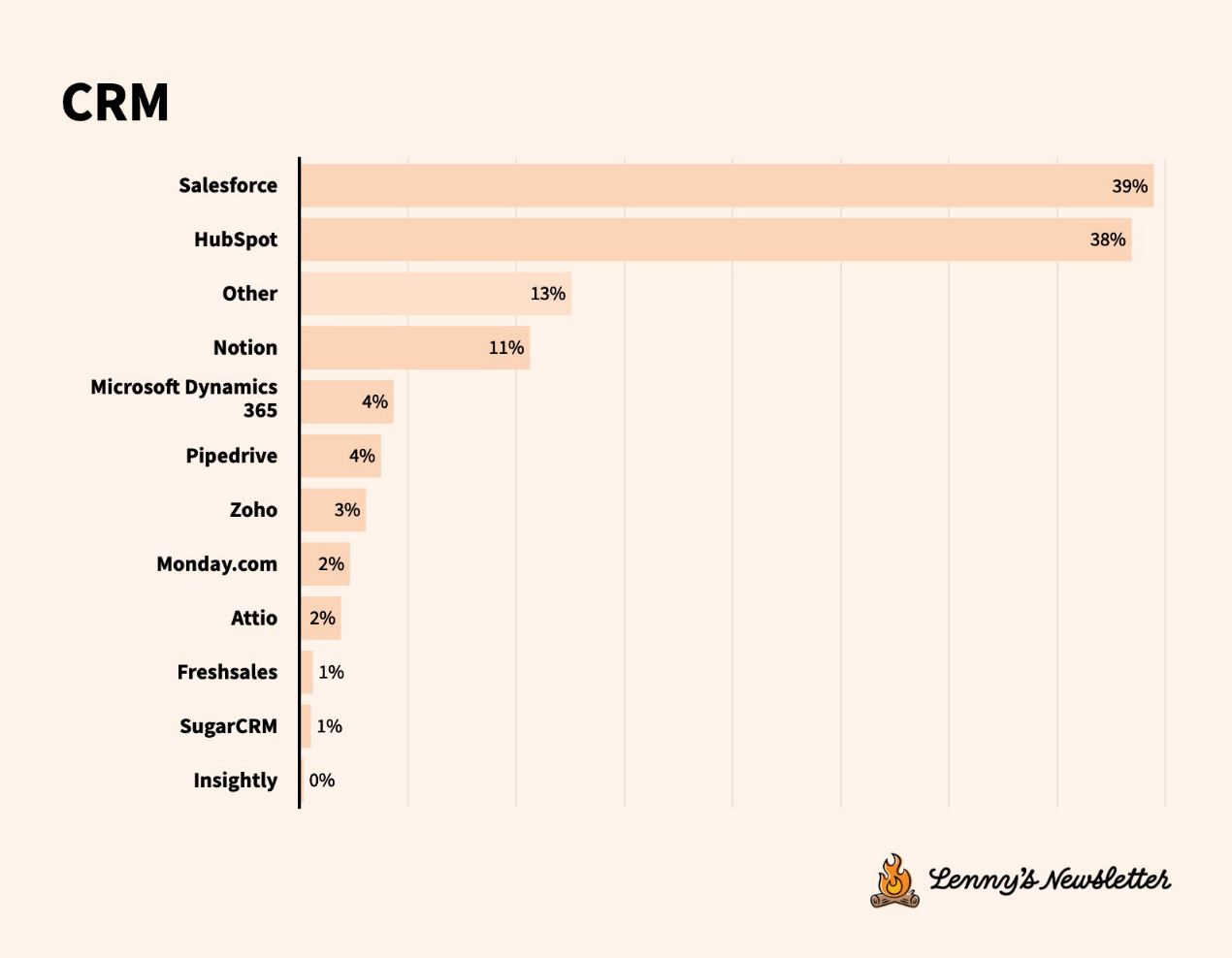
The customer support tools space showed a similar pattern of established leaders, with Zendesk maintaining its position as the leading support platform at 29%.
But interestingly, Slack also has a market share of 29%. Why?
Assume that the respondents to this survey skew toward early-stage companies. Slack is a necessity, while Zendesk or Intercom are expensive and complicated.
Slack lets you create an external shared channel for each client or design partner, so co-founders or early employees can communicate directly with their clients. This insight reveals another variable behind Salesforces decision to acquire Slack for nearly $30 billion a few years ago.
Three main points: bundling, careful design, and mashup
1. Bundling is powerful, but limited
Some of the most commonly used tools like Jira, Microsoft Teams, and Google Slides are all bundled into their respective enterprise stacks, which locks users in for a long time and creates huge switching costs. They ultimately “win” because of the bundling, but some of these products top the “least liked” and “most wanted to switch” lists, so it may only be a matter of time before some better-made and better-executed startups (e.g. Linear, Figma Slides) find a way to break through and seize the lead.
2. Well-built products are disrupting existing products
Linear, Notion, Figma Slides, and Slack were all praised for their user experience, fit with workflow, and focus on a flawless feature set. They are fast rising (or already winning) and are at the top of respondents’ list of apps they would like to switch to.
3. Mix and match different tools in the same field
When looking at the tool stack landscape more holistically, it turns out that for core tasks, users use several (competing) tools in the same category depending on their needs. For example, most respondents use multiple AI assistants based on the strengths of each assistant.
The tools people value most, and the ones they would give up if they could
In the survey, respondents were asked to select up to three tools they valued most and least, expecting there to be no overlap between the two choices. This turned out to be wrong, with tools like Slack, Jira, and even ChatGPT frequently mentioned in both lists. A better metric was needed to capture the value of a tool while taking into account two key factors:
The overall frequency with which the tool was selected.
In addition to the most valuable tools, tools were listed as the least valued frequently.
The survey adjusted the rankings based on the ratio of generally popular to most valuable and the ratio of most valuable to least valuable, penalizing tools that were near the top of either list. The result is an adjusted most valuable metric.
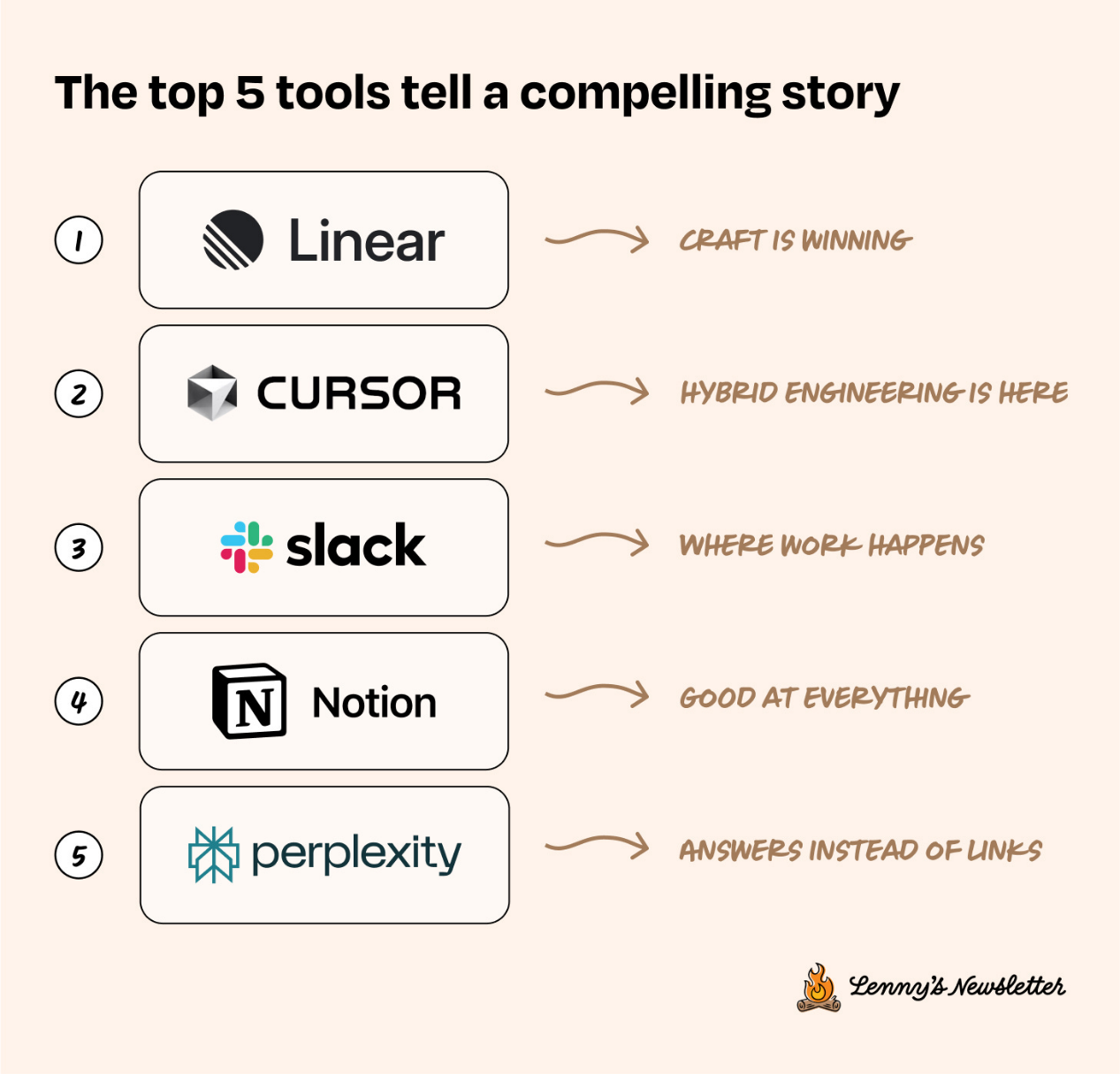
Linear: Victory in design
Respondents liked Linears user experience, its fit with their workflow, and its relative simplicity and focus compared to Jira.
Cursor: The future of software development is AI-native
Cursor is rising at an astonishing rate, alongside at least five other AI-native coding platforms. More than 20% of engineers already rely on Cursor, outperforming most other traditional coding tools like JetBrains, IntelliJ, and even Xcode.
Slack: A Place for Work
When it comes to Slack, it’s not all love. Slack tops the “most valuable” list, but it also ranks high on the “least valuable” list. Users rely heavily on Slack to communicate, but some also consider it a productivity killer. Some respondents described it as “adding a lot of cognitive load” and a “noise generator.” Still, in an age where communication is getting faster and faster, Slack is the place to get work done.
Notion: Good Enough for Everything
There’s a new crop of modern tools. Notion stands out as representing a new breed of tools that prioritize collaboration, intuitive design, and flexibility to accomplish a range of tasks, from documentation to project management to collaboration.
Perplexity: Provide answers instead of links
Beyond the popularity of ChatGPT and Claude, the top five Perplexity rankings tell us something important: AI tools are no longer just shiny toys; they are changing our workflows, replacing mature tools (like Google), and becoming essential to our workdays.
The Tools I Most Want to Replace List
The survey also asked respondents which tools they would most like to replace, and which tools they would most like to use.
People seem to think that Linear, Slack, and Notion are the modern stack for project management, communication, and collaboration. Atlassian’s Jira and Confluence are not doing well, and so is Microsoft Teams.
Other key insights: User research, analytics, emails
1. User Research
Survey tool approved
Google Forms dominates, especially among PMs, probably because of its simplicity, full functionality, and its bundling with Google Workspace.
However, Typeform is the perfect tool for reimagining a stale format. With a richer feature set, a less traditional approach, and a more carefully crafted design, it ranks third among user research tools.
User Interviews will change the recruiting landscape
User Interviews climbed to the second spot by solving one of the biggest pain points in research: finding the right people to talk to. Think about it, what good is a perfectly planned research study if you can’t find the right participants? Respondents love User Interviews because it turns the tedious process of finding, scheduling, and paying participants into a manageable process.
Professional Team
A host of specialized tools are changing the way teams understand their users:
UserTesting Still Occupies the Usability Game
Qualtrics takes on enterprise-level customer experience research
Dovetail has an edge in insight management
Maze makes research fast and easy
Sprig is an always-on product experience platform
Optimal Workshop Solve Information Architecture Problems
Dscout has diaries and longitudinal studies
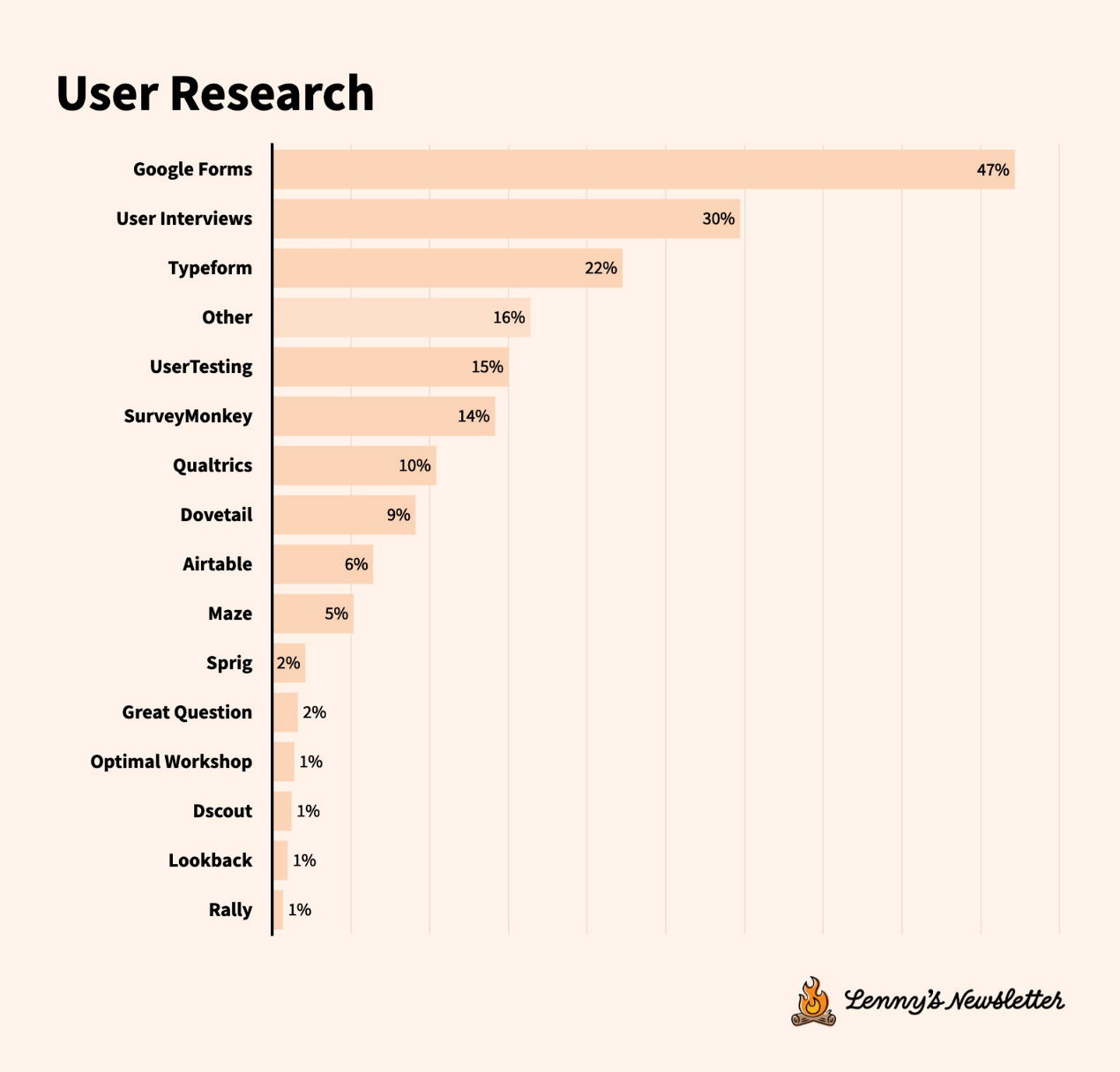
2. Analysis
The data analytics landscape in 2025 tells a story of David vs. Goliath, or more accurately, a story of several Goliaths and a group of Davids.
Google Analytics remains the undisputed number one, dominating general analytics, but interestingly, a thriving ecosystem of specialized tools is carving out their own niche.
Powerful players
When teams need to level up their business intelligence, they increasingly turn to two main players:
Tableau: A platform that simplifies complex data into compelling dashboards.
Looker: A favorite among data scientists, Looker is helping democratize data among companies. ”
Behavior tracking favorites
Amplitude and Mixpanel remain the two largest analytics companies after Google Analytics, helping teams track everything from user behavior to feature adoption.
Develop your own market segment
Highly specialized tools are emerging:
Hotjar dominates the qualitative space with its heatmaps and session recordings
Metabase has become a favorite among startups, providing fast, useful dashboards
Pendo has a lot of product feedback
Segment is the first choice for data management
Fullstory and Heap are gaining fame in behavioral data collection
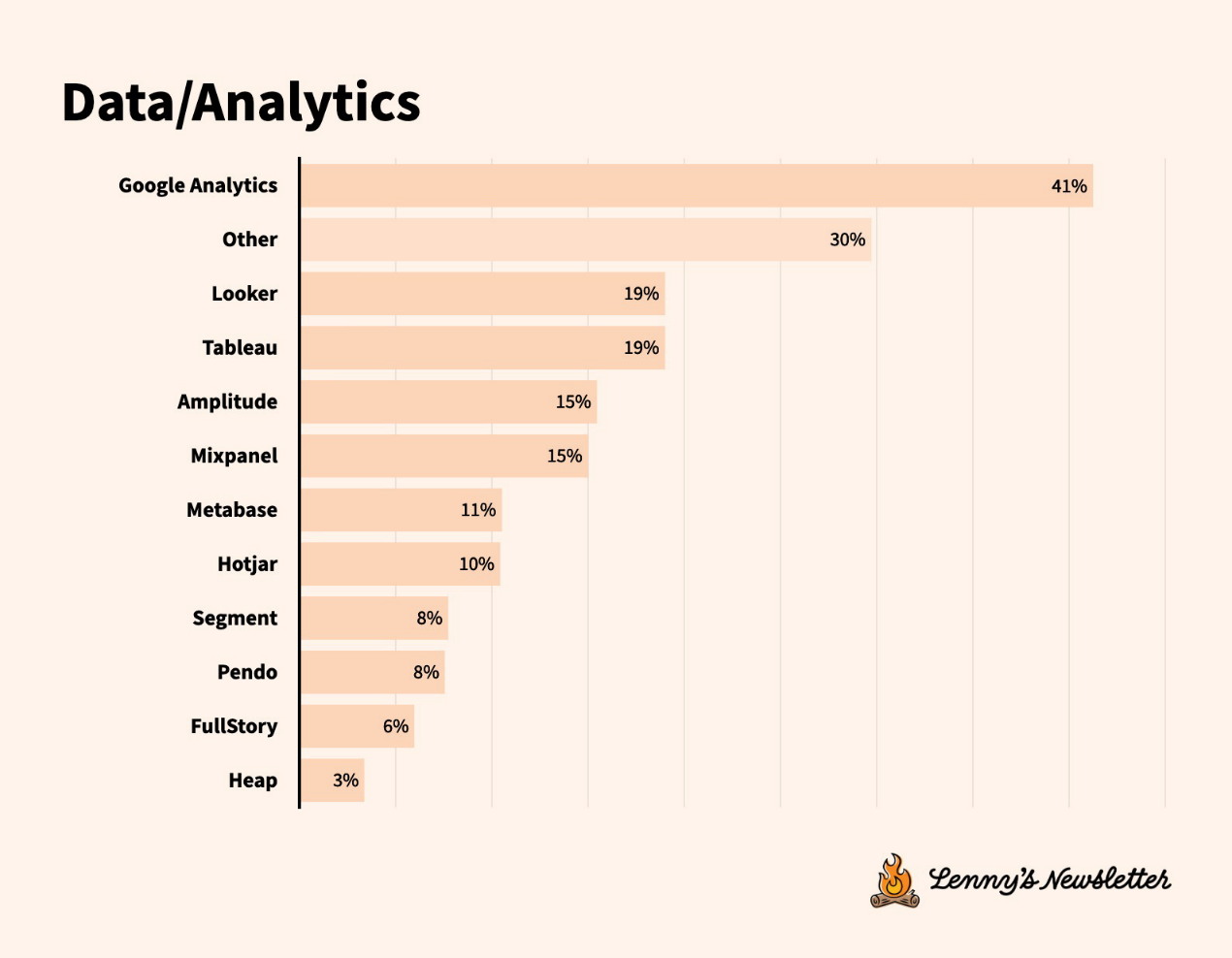
30% of respondents responded in the “other” category. The two leading platforms were evenly matched with around 200 responses each:
Posthog: An open source all-in-one platform that competes with big players like Amplitude, Mixpanel, Fullstory, and Heap.
Power BI: Microsofts answer to Salesforces Tableau and Googles Looker. Data analysis, visualization, dashboards... Often the default choice for companies using the Microsoft stack.
3. Email: Three camps
Emails basically fall into three categories:
Gmail
Microsoft Outlook
Special tools for advanced users
Gmail ranked second in overall tool popularity, behind ChatGPT but ahead of Slack and all other email tools. In addition, Google Workspace was rated significantly higher than Microsoft Suite throughout the survey.
Microsoft still maintains its enterprise position, but the satisfaction gap is widening. Their tools appear repeatedly in the “least popular” rankings, as one respondent said of Outlook, “Everything about Outlook feels corporate and soulless compared to Google Suite, but the inertia of the enterprise keeps us from moving away from it.”
Power users gravitate toward professional tools like Superhuman and Front, which are still relatively niche, but users report significant productivity gains that justify the higher costs.
Overall
When looking at this data as a whole, a few important trends become clear. First, AI isn’t just the new normal, it’s everywhere. Teams aren’t just leveraging AI, they’re building entire workflows around it. ChatGPT not only stood out, it dominated. Respondents said ChatGPT served a dual purpose: it expanded their thinking when ideating or brainstorming, and it streamlined key workflows like data analysis or writing.
Another theme that runs throughout is that user experience is more important than functionality when choosing a tool. Teams are increasingly willing to sacrifice deep functionality for tools that really work. Tools like Linear, Notion, Slack, and Figma are appreciated for their sleek design and flexibility.
This is why you may see an acceleration in tool migration. There is strong negative sentiment towards tools that don’t meet the standards of the modern stack, and there is a strong desire to switch from older tools to those modern alternatives. Bundling strategies can only work so far, and well-built tools will steal the market.
Savvy teams and individuals mix and match tools within the same domain, choosing the most appropriate tool for each nuanced situation or need.
One thing is clear: people in the tech world are always on the lookout for better tools.

